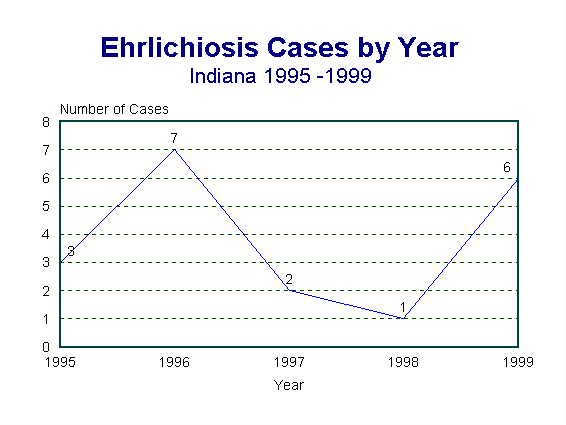
Ehrlichiosis
Cases
= 6Six cases of human monocytic ehrlichiosis reported in Indiana in 1999 were from four counties. Nineteen cases have been reported in Indiana in the past 5 years. Reported cases by year are presented in Figure 1. County of residence of the 1999 cases is presented in Figure 2. County of residence for cases reported since 1994 is presented in Figure 3. Case distribution by sex is presented in Figure 4. Female to male case ratio is 1:2.2. This distribution may be related to differences in occupational and recreational exposures. Age range for female cases for the past five years is 7-76 with a mean age of 52 years. Age range for male cases for the same time is 3-79 with a mean age of 42 years.
Figure 1.

|
Figure 2.
|
Figure 3 .
|
Figure 4.

Ehrlichiosis is an acute febrile illness whose spectrum of illness ranges from so mild as not to require medical treatment to life-threating or death. Most commonly reported symptoms are fever, headache, anorexia, nausea, myalgia, and vomiting. Thrombocytopenia and abnormal liver function test results, particularly increased hepatic transaminase levels, have also been noted. The disease resembles Rocky Mountain Spotted Fever without the rash. Diagnosis requires laboratory confirmation by indirect fluorescent antibody testing. Treatment with a tetracycline or chloramphenicol for pregnant women and children less than 8 years of age has been reported to be effective.
Ehrlichiosis was first recognized in the United States in 1986. The causative agent of human monocytic ehrlichiosis (HME) is Ehrlichia chaffeensis, a new member in the genus of Ehrlichia, family of Rickettsiaceae. Ehrlichia chaffeensis is closely related to E. canis, the causative agent of canine ehrlichiosis. Epidemiological data indicates that most cases of HME are found in the south central or southeastern United States. Amblyomma americanum, the lone star tick is a suspected vector.
An unspecified Ehrlichia causes human granulocytic ehrlichiosis (HGE). This organism is closed related to both E. phagocytophila and E. equi. Ixodes scapularis, the deer tick, is the most important vector. HGE has so far been limited to the upper Midwest and East Coast states. No human infections have been reported in Indiana to date.
[an error occurred while processing this directive]